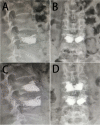Risk factors for recollapse of new vertebral compression fractures after percutaneous kyphoplasty in geriatric patients: establishment of a nomogram
- PMID: 35568857
- PMCID: PMC9107663
- DOI: 10.1186/s12891-022-05409-3
Risk factors for recollapse of new vertebral compression fractures after percutaneous kyphoplasty in geriatric patients: establishment of a nomogram
Abstract
Background: The main objective of this study was to investigate the risk factors for recollapse of new vertebral compression fractures (NVCFs) after percutaneous kyphoplasty (PKP) treatment for osteoporotic vertebral compression fracture (OVCF) and to construct a new nomogram model.
Methods: We retrospectively analysed single-level OVCFs from January 2017 to June 2020, randomizing patients to a training set and a testing set. In the training set, independent risk factors for NVCFs in OVCF patients treated with PKP were obtained by univariate and multivariate regression analyses. These risk factors were then used as the basis for constructing a nomogram model. Finally, internal validation of the built model was performed in the testing set using the consistency index (C-index), receiver operating characteristic (ROC) curves, calibration curves and decision curve analysis (DCA).
Results: In total, 371 patients were included in this study. NVCFs occurred in 21.7% of the training set patients, and multivariate regression analysis showed that a low Hounsfield unit (HU) value, cement leakage, and thoracolumbar (TL) junction fracture were independent risk factors for NVCF after PKP. The C-index was 0.81 (95% CI: 0.74-0.81), and the validation showed that the predicted values of the established model were in good agreement with the actual values.
Conclusions: In this study, three independent risk factors were obtained by regression analysis. A nomogram model was constructed to guide clinical work and to make clinical decisions relatively accurately to prevent the occurrence of vertebral recollapse fractures.
Keywords: Nomogram; Osteoporotic vertebral compression fracture; Percutaneous kyphoplasty; Risk factor.
© 2022. The Author(s).
Conflict of interest statement
The authors declare that they have no competing interest.
Figures






Similar articles
-
Development and validation of a nomogram for predicting the probability of new vertebral compression fractures after vertebral augmentation of osteoporotic vertebral compression fractures.BMC Musculoskelet Disord. 2021 Nov 16;22(1):957. doi: 10.1186/s12891-021-04845-x. BMC Musculoskelet Disord. 2021. PMID: 34784910 Free PMC article.
-
Development and validation of a nomogram for predicting new vertebral compression fractures after percutaneous kyphoplasty in postmenopausal patients.J Orthop Surg Res. 2023 Nov 30;18(1):914. doi: 10.1186/s13018-023-04400-5. J Orthop Surg Res. 2023. PMID: 38037128 Free PMC article.
-
Establishment and validation of a nomogram for predicting new fractures after PKP treatment of for osteoporotic vertebral compression fractures in the elderly individuals.BMC Musculoskelet Disord. 2023 Sep 12;24(1):728. doi: 10.1186/s12891-023-06801-3. BMC Musculoskelet Disord. 2023. PMID: 37700293 Free PMC article.
-
Establishment and validation of a nomogram and web calculator for the risk of new vertebral compression fractures and cement leakage after percutaneous vertebroplasty in patients with osteoporotic vertebral compression fractures.Eur Spine J. 2022 May;31(5):1108-1121. doi: 10.1007/s00586-021-07064-z. Epub 2021 Nov 25. Eur Spine J. 2022. PMID: 34822018 Review.
-
Analysis of two minimally invasive procedures for osteoporotic vertebral compression fractures with intravertebral cleft: a systematic review and meta-analysis.J Orthop Surg Res. 2020 Sep 10;15(1):401. doi: 10.1186/s13018-020-01938-6. J Orthop Surg Res. 2020. PMID: 32912267 Free PMC article.
Cited by
-
Risk factors and strategies for recovery quality, postoperative pain, and recurrent fractures between percutaneous kyphoplasty and percutaneous vertebroplasty in elderly patients with thoracolumbar compression fractures: a retrospective comparative cohort study.Ann Transl Med. 2023 Jan 31;11(2):122. doi: 10.21037/atm-22-6475. Ann Transl Med. 2023. PMID: 36819492 Free PMC article.
-
A nomogram for predicting the risk of new vertebral compression fracture after percutaneous kyphoplasty.Eur J Med Res. 2023 Aug 11;28(1):280. doi: 10.1186/s40001-023-01235-y. Eur J Med Res. 2023. PMID: 37563667 Free PMC article.
-
Risk factors of new vertebral compression fracture after percutaneous vertebroplasty or percutaneous kyphoplasty.Front Endocrinol (Lausanne). 2022 Aug 31;13:964578. doi: 10.3389/fendo.2022.964578. eCollection 2022. Front Endocrinol (Lausanne). 2022. PMID: 36120447 Free PMC article.
-
Risk Factors for New Vertebral Compression Fracture After Percutaneous Vertebral Augmentation: A Retrospective Study.Med Sci Monit. 2023 Jul 18;29:e940134. doi: 10.12659/MSM.940134. Med Sci Monit. 2023. PMID: 37461206 Free PMC article.
-
Vertebral CT Hounsfield units in postmenopausal women with osteoporotic vertebral compression fracture: identification and validation of reference intervals.Eur Spine J. 2025 May;34(5):1663-1672. doi: 10.1007/s00586-025-08828-7. Epub 2025 Apr 3. Eur Spine J. 2025. PMID: 40175644
References
-
- Buchbinder R, Golmohammadi K, Johnston RV, Owen RJ, Homik J, Jones A, Dhillon SS, Kallmes DF, Lambert RG. Percutaneous vertebroplasty for osteoporotic vertebral compression fracture. Cochrane Database Syst Rev. 2015;4:CD006349. - PubMed
-
- Korovessis P, Vardakastanis K, Repantis T, Vitsas V. Balloon kyphoplasty versus KIVA vertebral augmentation--comparison of 2 techniques for osteoporotic vertebral body fractures: a prospective randomized study. Spine (Phila Pa 1976) 2013;38(4):292–299. doi: 10.1097/BRS.0b013e31826b3aef. - DOI - PubMed
MeSH terms
Substances
LinkOut - more resources
Full Text Sources
Medical

